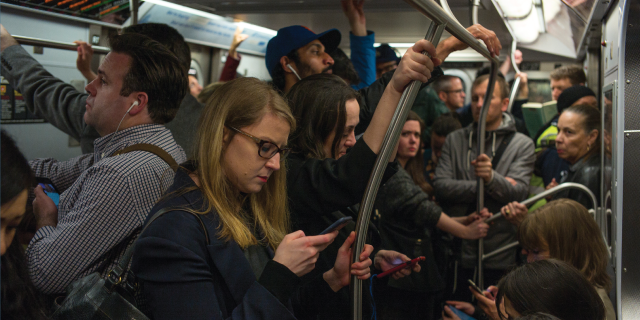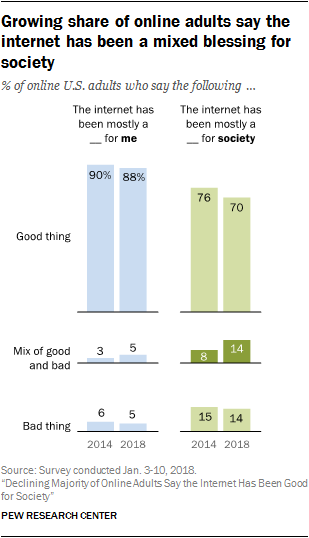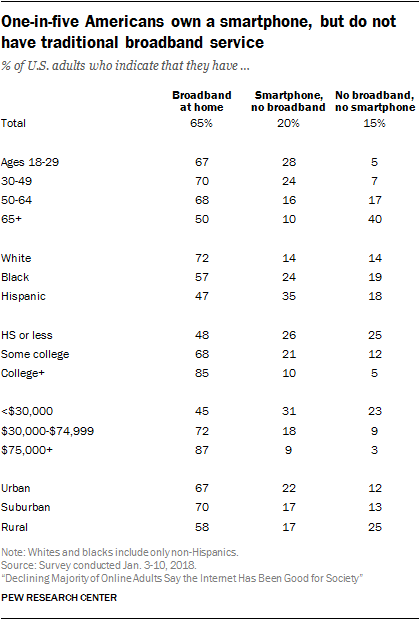
Americans tend to view the impact of the internet and other digital technologies on their own lives in largely positive ways, Pew Research Center surveys have shown over the years. A survey of U.S. adults conducted in January 2018 finds continuing evidence of this trend, with the vast majority of internet users (88%) saying the internet has, on balance, been a mostly good thing for them personally.
But even as they view the internet’s personal impact in a positive light, Americans have grown somewhat more ambivalent about the impact of digital connectivity on society as a whole. A sizable majority of online adults (70%) continue to believe the internet has been a good thing for society. Yet the share of online adults saying this has declined by a modest but still significant 6 percentage points since early 2014, when the Center first asked the question. This is balanced by a corresponding increase (from 8% to 14%) in the share of online adults who say the internet’s societal impact is a mix of good and bad. Meanwhile, the share saying the internet has been a mostly bad thing for society is largely unchanged over that time: 15% said this in 2014, and 14% say so today.
This shift in opinion regarding the ultimate social impact of the internet is particularly stark among older Americans, despite the fact that older adults have been especially rapid adopters of consumer technologies such as social media and smartphones in recent years. Today 64% of online adults ages 65 and older say the internet has been a mostly good thing for society. That represents a 14-point decline from the 78% who said this in 2014. The attitudes of younger adults have remained more consistent over that time: 74% of internet users ages 18 to 29 say the internet has been mostly good for society, comparable to the 79% who said so in 2014.
As was true in our 2014 survey, college graduates are more likely than those with lower levels of educational attainment to say the internet has had a positive impact on society (and less likely to say it has had a negative impact). Among online adults with a college degree, 81% say the impact of the internet on society has been mostly good and just 7% say it has been mostly bad. By contrast, 65% of those with a high school diploma or less say the internet has had a mostly good impact on society, and 17% say its impact has been mostly bad.
Positive views of the internet are often tied to information access and connecting with others; negative views are based on a wider range of issues
Those who think the internet has had a good impact on society tended to focus on two key issues, according to follow-up items which allowed respondents to explain their views in their own words. Most (62% of those with a positive view) mentioned how the internet makes information much easier and faster to access. Meanwhile, 23% of this group mentioned the ability to connect with other people, or the ways in which the internet helps them keep more closely in touch with friends and family.
By contrast, those who think the internet is a bad thing for society gave a wider range of reasons for their opinions, with no single issue standing out. The most common theme (mentioned by 25% of these respondents) was that the internet isolates people from each other or encourages them to spend too much time with their devices. These responses also included references to the spread and prevalence of fake news or other types of false information: 16% mentioned this issue. Some 14% of those who think the internet’s impact is negative cited specific concerns about its effect on children, while 13% argued that it encourages illegal activity. A small share (5%) expressed privacy concerns or worries about sensitive personal information being available online.
One-in-five Americans are now ‘smartphone only’ internet users at home
These attitudinal changes are occurring in a broader landscape in which the access options available to ordinary Americans are shifting dramatically. Most notably, fully one-in-five Americans (20%) are now “smartphone only” internet users at home – that is, they own a smartphone but do not subscribe to traditional broadband service where they live. This represents a 7-point increase compared with data from 2015, when 13% of Americans were smartphone-only users. Roughly two-thirds of Americans (65%) say they subscribe to traditional broadband service at home, similar to the 67% who said this in July 2015.1
As has consistently been true in past surveys conducted by the Center, those who rely on their smartphones for home internet service are disproportionately less likely to have attended college compared with those with traditional broadband service. They also report living in lower-income households. For instance, 31% of Americans with an annual household income of less than $30,000 are smartphone-only internet users, more than three times the share among those living in households earning $75,000 or more per year (9%). This phenomenon is also notably more prevalent among blacks and Hispanics than among whites.
Conversely, relatively well-educated and financially well-off Americans are substantially more likely to say they do have a traditional broadband connection at home. Nearly nine-in-ten Americans in households earning $75,000 or more per year say they subscribe to home broadband service, nearly double the rate among those earning less than $30,000 per year (45% of whom have broadband service at home).
Beyond this growing reliance on smartphones for home internet service in lieu of traditional broadband service, it is also notable that 15% of Americans indicate that they have neither broadband service at home nor a smartphone. A large share of this group is not online at all: 11% of Americans indicate that they do not use the internet or email from any location. In other cases, the share without home broadband or a smartphone represents Americans who go online using other means.
And as was the case with smartphone-only internet usage, those who lack both broadband service and a smartphone are disproportionately likely to be from certain segments of the population. Most notably, 40% of Americans ages 65 and older fall into this category. But this is also true for substantial minorities of rural residents (25%), those who have not attended college (25%) and those from households earning less than $30,000 per year (23%).






